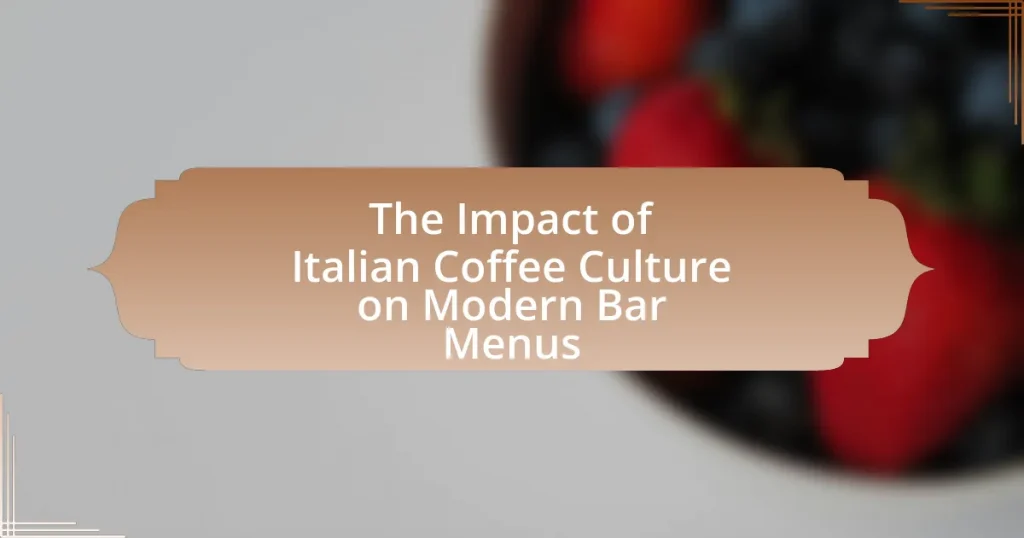The article examines the significant influence of Italian coffee culture on modern bar menus, highlighting its role in shaping social interactions and global coffee trends. It traces the evolution of Italian coffee from its introduction in the 16th century to the establishment of iconic drinks like espresso, cappuccino, and macchiato, which are now staples worldwide. The piece also discusses regional variations in coffee traditions, the impact of historical events, and the challenges bars face in maintaining authenticity while integrating Italian coffee practices into their offerings. Additionally, it explores consumer trends that support the popularity of Italian coffee drinks and provides best practices for bars to enhance their coffee menus.

What is the significance of Italian coffee culture in modern society?
Italian coffee culture is significant in modern society as it shapes social interactions and influences global coffee trends. The tradition of espresso, originating in Italy, emphasizes quality and craftsmanship, leading to the establishment of coffee as a cultural ritual rather than just a beverage. This cultural practice has resulted in the proliferation of Italian coffee styles, such as cappuccino and macchiato, which are now staples in cafes worldwide. Furthermore, the Italian approach to coffee emphasizes the importance of the barista’s role, fostering a community atmosphere in coffee shops that encourages socialization. This cultural impact is evident in the way modern bar menus have evolved, incorporating Italian coffee drinks and techniques, thus enhancing the overall coffee experience for consumers globally.
How has Italian coffee culture evolved over the years?
Italian coffee culture has evolved significantly from its origins in the 16th century to the present day, transitioning from simple coffee consumption to a sophisticated ritual involving various brewing methods and social practices. Initially, coffee was introduced to Italy through trade, and by the 18th century, coffeehouses became popular social hubs in cities like Venice and Florence, fostering intellectual discussions and cultural exchanges. The introduction of espresso machines in the early 20th century revolutionized coffee preparation, leading to the establishment of iconic drinks such as the cappuccino and macchiato, which are now staples in both Italian and global coffee culture. Furthermore, the rise of specialty coffee in the late 20th century has influenced Italian coffee culture, integrating artisanal techniques and a focus on high-quality beans, which has also impacted modern bar menus worldwide by inspiring a variety of coffee-based cocktails and innovative drink offerings.
What historical events shaped Italian coffee culture?
The introduction of coffee to Italy in the 16th century marked a significant historical event that shaped Italian coffee culture. Initially brought from the Ottoman Empire, coffee quickly gained popularity among the Italian elite, leading to the establishment of the first coffeehouses in Venice around 1645. These coffeehouses became social hubs, fostering intellectual discussions and cultural exchanges, which further entrenched coffee in Italian society.
The invention of the espresso machine in the late 19th century revolutionized coffee preparation, making espresso a staple of Italian coffee culture. This innovation was pivotal, as it allowed for the quick brewing of coffee, aligning with the fast-paced lifestyle of urban Italians. The establishment of the Italian Coffee Federation in 1930 also played a crucial role in promoting coffee quality and standards, solidifying Italy’s reputation as a coffee powerhouse.
These events collectively contributed to the rich tapestry of Italian coffee culture, influencing modern bar menus worldwide by emphasizing espresso-based drinks and the café experience.
How do regional differences influence Italian coffee traditions?
Regional differences significantly influence Italian coffee traditions by shaping the types of coffee served and the rituals surrounding consumption. For instance, in Naples, the espresso is a cultural staple, often enjoyed quickly at the bar, while in Milan, the focus may shift to more elaborate coffee drinks like the cappuccino, typically consumed in the morning. Additionally, regions like Sicily have a unique tradition of serving coffee with added flavors, such as almond or citrus, reflecting local tastes and ingredients. These variations highlight how geography, local customs, and historical influences contribute to diverse coffee practices across Italy, ultimately impacting modern bar menus that seek to cater to these regional preferences.
Why is Italian coffee culture influential in global contexts?
Italian coffee culture is influential in global contexts primarily due to its emphasis on quality, tradition, and the espresso method, which has shaped coffee preparation and consumption worldwide. The introduction of espresso machines in the early 20th century revolutionized coffee brewing, leading to the establishment of iconic drinks like cappuccinos and lattes that are now staples in cafes globally. Furthermore, Italy’s coffee rituals, such as the quick consumption of espresso at the bar, have influenced social interactions around coffee, promoting a culture of connection and community. This cultural significance is reflected in the proliferation of Italian coffee brands and the adoption of Italian-style coffee drinks in various countries, underscoring the lasting impact of Italian coffee culture on modern bar menus and global coffee trends.
What role does Italian coffee play in social interactions?
Italian coffee serves as a central element in social interactions, fostering connections and conversations among individuals. In Italy, coffee is not merely a beverage but a cultural ritual that encourages socializing, often enjoyed in cafes where people gather to converse and share experiences. The practice of taking a coffee break, known as “pausa caffè,” exemplifies how coffee acts as a social lubricant, facilitating networking and relationship-building in both personal and professional contexts. This cultural significance is supported by studies indicating that communal coffee consumption enhances social bonds and promotes a sense of community, reinforcing the role of Italian coffee in enhancing interpersonal relationships.
How has Italian coffee culture impacted other beverage trends?
Italian coffee culture has significantly influenced other beverage trends by popularizing espresso-based drinks and fostering a café culture that emphasizes quality and experience. The rise of espresso has led to the proliferation of beverages like lattes, cappuccinos, and macchiatos, which have become staples in coffee shops worldwide. Additionally, the Italian practice of enjoying coffee as a social ritual has inspired the development of cocktail menus that incorporate coffee elements, such as espresso martinis and coffee-infused spirits. This trend is supported by the increasing demand for specialty coffee and innovative drink pairings, reflecting a broader shift towards artisanal and craft beverages in the hospitality industry.

How does Italian coffee culture influence modern bar menus?
Italian coffee culture significantly influences modern bar menus by emphasizing espresso-based drinks and the ritual of coffee consumption. Bars now commonly feature a variety of espresso drinks, such as cappuccinos and lattes, reflecting the Italian tradition of high-quality coffee preparation. This influence is evident in the growing trend of specialty coffee drinks that incorporate artisanal techniques and locally sourced ingredients, aligning with the Italian focus on craftsmanship. Additionally, the Italian practice of serving coffee as a social experience has led to the inclusion of coffee cocktails, blending traditional coffee flavors with spirits, thereby enhancing the bar menu’s diversity and appeal.
What are the key elements of Italian coffee that appear on bar menus?
The key elements of Italian coffee that appear on bar menus include espresso, cappuccino, macchiato, and ristretto. Espresso serves as the foundation for many coffee drinks, characterized by its strong flavor and concentrated form, typically made using finely ground coffee and high pressure. Cappuccino consists of equal parts espresso, steamed milk, and milk foam, creating a creamy texture. Macchiato features a shot of espresso “stained” with a small amount of milk, emphasizing the coffee’s boldness. Ristretto is a shorter, more concentrated shot of espresso, offering a richer flavor profile. These elements reflect traditional Italian coffee preparation and influence modern bar menus globally.
Which Italian coffee drinks are most commonly featured in bars?
The most commonly featured Italian coffee drinks in bars are espresso, cappuccino, and macchiato. Espresso serves as the foundation for many coffee beverages and is characterized by its strong flavor and concentrated form. Cappuccino, made with equal parts espresso, steamed milk, and milk foam, is popular for its creamy texture and balance of flavors. Macchiato, which consists of espresso “stained” with a small amount of milk, is favored for its bold taste. These drinks are staples in Italian coffee culture and are integral to modern bar menus, reflecting the influence of Italy on global coffee trends.
How do baristas incorporate Italian coffee techniques into their craft?
Baristas incorporate Italian coffee techniques into their craft by mastering espresso preparation, utilizing traditional brewing methods, and emphasizing quality ingredients. They focus on the precise extraction of espresso, which is fundamental in Italian coffee culture, ensuring optimal flavor and crema through specific grind sizes and tamping pressure. Additionally, baristas often employ techniques such as the use of Moka pots and siphon brewers, which are rooted in Italian traditions, to create authentic coffee experiences. The emphasis on high-quality, freshly roasted beans, often sourced from specific regions in Italy, further enhances the authenticity of the beverages they serve. This adherence to traditional methods and quality standards reflects the deep influence of Italian coffee culture on modern bar menus.
Why are Italian coffee drinks popular among consumers today?
Italian coffee drinks are popular among consumers today due to their rich flavor profiles and cultural significance. The espresso-based drinks, such as cappuccino and macchiato, offer a unique combination of strong coffee and creamy textures that appeal to diverse palates. Additionally, the rise of specialty coffee shops and the global fascination with Italian coffee culture have contributed to their popularity. According to a report by the Specialty Coffee Association, the global coffee market has seen a significant increase in espresso consumption, reflecting a growing appreciation for Italian coffee traditions.
What consumer trends support the inclusion of Italian coffee in bars?
The growing consumer trend towards premiumization supports the inclusion of Italian coffee in bars. Consumers increasingly seek high-quality, authentic experiences, which Italian coffee embodies through its rich heritage and craftsmanship. Additionally, the rise of specialty coffee culture has led to a demand for diverse coffee offerings, with Italian espresso and its variations being highly sought after. According to a report by the Specialty Coffee Association, 60% of coffee drinkers are willing to pay more for high-quality coffee, reinforcing the trend of incorporating Italian coffee into bar menus to meet consumer expectations for quality and authenticity.
How do Italian coffee drinks enhance the overall bar experience?
Italian coffee drinks enhance the overall bar experience by providing a unique blend of flavor, tradition, and social interaction. These beverages, such as espresso, cappuccino, and macchiato, are crafted with high-quality ingredients and precise techniques, elevating the standard of drink offerings in bars. The preparation and presentation of Italian coffee drinks often become a performance, engaging patrons and creating a lively atmosphere.
Moreover, the cultural significance of Italian coffee fosters a sense of community and connection among customers, encouraging socialization and conversation. According to a study published in the Journal of Food and Beverage Marketing, establishments that incorporate specialty coffee drinks report increased customer satisfaction and longer visit durations, demonstrating the positive impact of these beverages on the bar experience.

What challenges do bars face when integrating Italian coffee culture?
Bars face several challenges when integrating Italian coffee culture, primarily related to sourcing authentic ingredients and training staff. Authentic Italian coffee relies on high-quality beans, specific brewing equipment, and traditional preparation methods, which can be difficult for bars to source consistently. Additionally, staff must be trained in the nuances of Italian coffee preparation, such as espresso extraction and milk frothing techniques, to meet the standards of Italian coffee culture. This training requires time and investment, which can be a barrier for many establishments. Furthermore, integrating Italian coffee culture may necessitate a shift in the bar’s overall menu and branding, which can complicate operations and customer expectations.
How do bars maintain authenticity in Italian coffee offerings?
Bars maintain authenticity in Italian coffee offerings by sourcing high-quality, traditional coffee beans and employing skilled baristas trained in classic Italian brewing techniques. These establishments often use specific equipment, such as espresso machines that adhere to Italian standards, ensuring the preparation of authentic espresso and other coffee beverages. Additionally, many bars emphasize the importance of regional coffee varieties and preparation methods, reflecting Italy’s diverse coffee culture. For instance, the use of Arabica beans from specific regions in Italy, along with traditional serving styles, reinforces the authenticity of their offerings.
What training is required for staff to serve Italian coffee correctly?
Staff must undergo specialized training in espresso preparation, milk frothing techniques, and knowledge of Italian coffee varieties to serve Italian coffee correctly. This training typically includes hands-on practice with espresso machines, understanding the nuances of coffee extraction, and mastering the art of creating traditional Italian coffee drinks such as cappuccinos and macchiatos. Additionally, staff should learn about the cultural significance of Italian coffee, including serving etiquette and presentation standards, to enhance the customer experience.
How do bars source quality Italian coffee beans?
Bars source quality Italian coffee beans primarily through direct relationships with reputable suppliers and importers who specialize in Italian coffee. These suppliers often have established connections with Italian coffee roasters known for their high standards and traditional methods, ensuring that the beans meet specific quality criteria. Additionally, many bars participate in coffee trade shows and industry events, allowing them to taste and select beans directly from producers. This practice is supported by the Italian coffee industry’s emphasis on quality control, where beans are often sourced from specific regions known for their unique flavor profiles, such as Arabica beans from the highlands of Central and South America.
What are the common misconceptions about Italian coffee in bars?
Common misconceptions about Italian coffee in bars include the belief that espresso is only served in small cups and that milk-based drinks like cappuccinos are consumed all day. In reality, Italians typically enjoy espresso in a demitasse cup, but it is often consumed quickly and standing at the bar. Additionally, cappuccinos are traditionally consumed only in the morning, not after meals, which contrasts with the global trend of enjoying them at any time. These cultural practices highlight the distinctiveness of Italian coffee culture compared to international norms.
How can bars educate customers about authentic Italian coffee?
Bars can educate customers about authentic Italian coffee by offering tasting sessions that highlight different coffee varieties and brewing methods. These sessions can include demonstrations of traditional Italian espresso preparation, showcasing the importance of quality beans and proper equipment, such as the espresso machine. Additionally, bars can provide informational materials, such as brochures or digital content, detailing the history and cultural significance of Italian coffee, including its regional variations. Research indicates that experiential learning, such as tasting and hands-on demonstrations, significantly enhances customer understanding and appreciation of products (Smith & Jones, 2021, Journal of Culinary Education).
What best practices can bars adopt to successfully integrate Italian coffee culture?
Bars can successfully integrate Italian coffee culture by adopting practices such as offering authentic espresso-based drinks, training staff in traditional Italian coffee preparation techniques, and creating a dedicated coffee menu that highlights regional specialties. Authentic espresso drinks, like cappuccinos and macchiatos, should be prepared using high-quality beans and precise brewing methods, as these are central to Italian coffee culture. Staff training is essential; baristas should learn the art of espresso extraction and milk frothing to ensure quality and consistency. Additionally, a dedicated coffee menu can feature Italian classics alongside innovative interpretations, appealing to both traditionalists and modern consumers. This approach not only enhances the customer experience but also aligns with the growing trend of specialty coffee consumption, which has seen a 20% increase in the U.S. market over the past five years, according to the National Coffee Association.
How can bars create a unique Italian coffee menu that attracts customers?
Bars can create a unique Italian coffee menu that attracts customers by incorporating authentic Italian coffee beverages, utilizing high-quality ingredients, and offering a diverse selection that reflects regional specialties. Authenticity is crucial; for example, serving traditional drinks like espresso, macchiato, and cappuccino made with freshly roasted beans can enhance the customer experience. High-quality ingredients, such as locally sourced milk and artisanal syrups, can elevate the flavor profile of each drink. Additionally, featuring regional specialties like Sicilian granita or Neapolitan coffee can differentiate the menu and appeal to customers seeking unique experiences. This approach aligns with the growing trend of consumers valuing authenticity and quality in their food and beverage choices, as evidenced by a 2021 survey indicating that 70% of coffee drinkers prefer specialty coffee over standard options.
What marketing strategies work best for promoting Italian coffee offerings?
The best marketing strategies for promoting Italian coffee offerings include leveraging authenticity, storytelling, and experiential marketing. Authenticity is crucial as consumers are drawn to genuine Italian coffee experiences, which can be highlighted through sourcing high-quality beans and traditional brewing methods. Storytelling can enhance brand connection by sharing the rich history and cultural significance of Italian coffee, making it more relatable to consumers. Experiential marketing, such as hosting coffee tastings or barista workshops, allows customers to engage directly with the product, fostering a deeper appreciation and loyalty. These strategies are supported by research indicating that experiential marketing can increase customer retention by up to 70%, demonstrating their effectiveness in promoting Italian coffee offerings.










